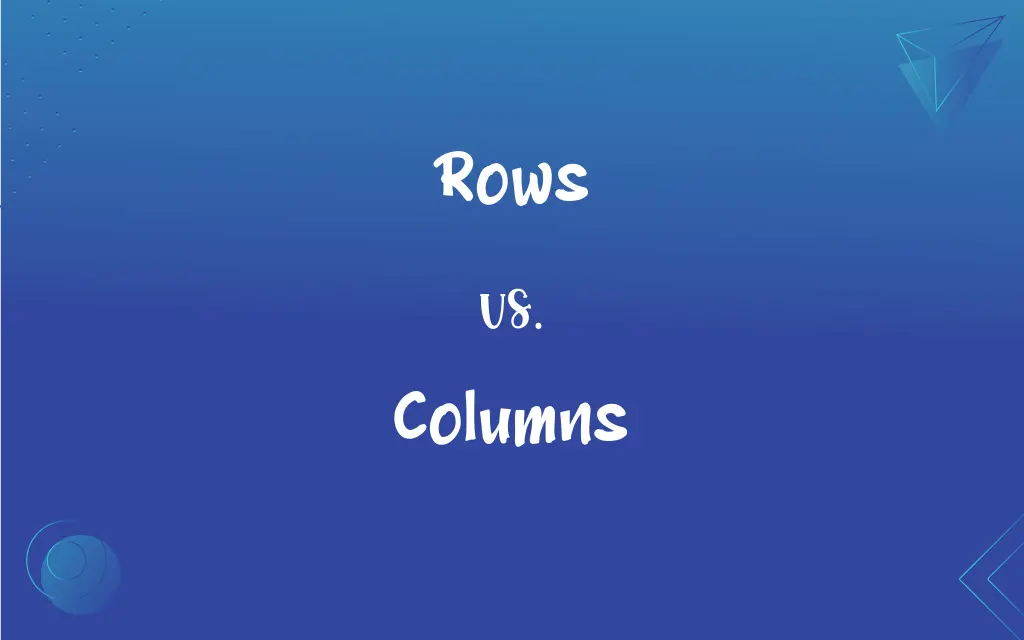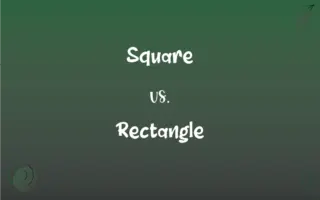Rows vs. Columns: What's the Difference?
Edited by Aimie Carlson || By Harlon Moss || Updated on October 6, 2023
Rows are horizontal sequences in a grid/matrix. Columns are vertical sequences in a grid/matrix.

Key Differences
Rows create horizontal alignments, extending from left to right across a plane, often within grids or matrices, essentially functioning as linear arrangements in a horizontal orientation. Whereas columns introduce vertical alignments, extending upward or downward, forming structured, perpendicular lines to the horizon, and often work to segment data or structures vertically.
In databases, rows are crucial for maintaining data entries, each one typically holding individual records or units of information that stand as distinguishable entities. Conversely, columns in databases pertain to the attributes or parameters of the data entries, defining particular characteristics that belong to the data set, serving as a critical dimension that provides depth and specification to the informational structure.
In architecture, rows often refer to linear sequences of items or structures, like houses or seats, arranged side by side, creating a lateral sequence that's easily navigable and coherent. In contrast, columns are architectural elements, typically vertical shafts, sometimes freestanding or embedded within walls, providing support to structures, often also serving as aesthetic enhancements, reinforcing the visual and functional integrity of buildings.
In mathematics and computer science, rows are vital for organizing matrices and arrays, helping streamline data and variables into coherent, horizontal structures, facilitating systematic data management and computation. Columns, conversely, enable vertical data alignments within matrices and arrays, allowing mathematical operations, like matrix multiplication and transformations, to be executed efficiently, thereby integrating into computational processes effectively.
In spreadsheets, like those in Excel, rows are identified with numbers and accommodate data in a left-to-right sequence, enabling users to insert, analyze, and manipulate data in a horizontal format, streamlining data analysis and visualization. Columns, identified by letters in spreadsheet software, facilitate vertical data input and analysis, enabling functions and formulas to traverse and manipulate data in a top-to-bottom orientation, proving indispensable in data management and analytics.
ADVERTISEMENT
Comparison Chart
Orientation
Horizontal
Vertical
In Databases
Represent records/data
Represent attributes
In Architecture
Linear arrangements
Supportive structures
In Spreadsheets
Identified by numbers
Identified by letters
Visual Representation
Left to right alignment
Upward/Downward alignment
ADVERTISEMENT
Rows and Columns Definitions
Rows
A linear arrangement of items side by side.
The farmer planted several rows of corn.
Columns
A military formation in which soldiers stand side by side in a line.
The soldiers marched in a column during the parade.
Rows
A sequence of objects or data in a horizontal line.
In the spreadsheet, each of the rows contained different financial data.
Columns
A supportive architectural feature, typically cylindrical.
The ancient ruins featured massive stone columns.
Rows
A noisy dispute or quarrel.
The neighbors had a loud row over the property line.
Columns
A regular section or article in a newspaper or magazine.
She writes a weekly column for the local newspaper.
Rows
To propel a boat using oars.
He will row the boat to the other side of the lake.
Columns
A vertical division of a page or text.
The newspaper article continued in the third column.
Rows
An act of propelling a boat with oars.
She spent the morning in a row across the tranquil lake.
Columns
A vertical array of numbers or data.
She added all the numbers in the spreadsheet column.
Rows
A series of objects placed next to each other, usually in a straight line.
Columns
A vertical structure usually consisting of a base, a cylindrical shaft, and a capital, used as a support or standing alone as a monument.
Rows
A succession without a break or gap in time
Won the title for three years in a row.
Columns
Any slender vertical support, as of steel or reinforced concrete.
Rows
A line of adjacent seats, as in a theater, auditorium, or classroom.
Columns
Something resembling an architectural column in form or function
A column of mercury in a thermometer.
FAQs
How are rows labeled in a spreadsheet?
Rows are typically labeled with numbers (1, 2, 3, ...) in a spreadsheet.
How are columns identified in spreadsheets?
Columns are usually identified by letters (A, B, C, ...) in spreadsheets.
Can rows and columns intersect?
Yes, rows and columns intersect at specific points called cells, where individual pieces of data reside in a grid or table.
What defines a column?
A column refers to a vertical arrangement of data or items, stretching from top to bottom in a table or grid.
How does database software utilize rows and columns?
In databases, rows typically hold records (entries) while columns define attributes (fields or parameters) pertaining to those records.
What is a row?
A row is a horizontal arrangement of data or items, extending from left to right in a table or grid.
Can the orientations of rows and columns be altered?
While traditionally horizontal for rows and vertical for columns, orientations can be conceptually inverted or rotated in specific applications or visual representations.
Is there a maximum number of rows and columns in spreadsheets?
Spreadsheet software like Excel often has set limits on rows and columns, but these limits are usually quite extensive (e.g., over a million rows).
What role do rows and columns play in matrices in mathematics?
In matrices, rows and columns organize and structure numerical data, facilitating operations like addition, multiplication, and transformations.
Are rows and columns relevant in web development?
Yes, rows and columns are fundamental in web development for structuring content, especially in grid systems and tabular data representation.
In what scenarios are the terms “rows” and “columns” used in architecture?
Architects might refer to "rows" of bricks or tiles and "columns" as vertical structural elements or arrangements of objects in space.
Can rows and columns exist independently outside of tables or grids?
While often associated with tables, "rows" and "columns" can describe linear arrangements in various contexts, independent of tables.
How does sorting data impact rows and columns?
Sorting data typically rearranges rows (entries) based on values within specific columns, while keeping column order intact.
What challenges might arise when working with large numbers of rows and columns?
Challenges might include managing and navigating vast data, ensuring accuracy during operations, and maintaining optimal software performance.
In which professions are the terms “rows” and “columns” commonly used?
Rows and columns are ubiquitous terms, notably utilized in professions like data analysis, programming, architecture, and various engineering fields.
How can rows and columns enhance data visualization?
Rows and columns systematically structure data, enhancing readability and interpretation in charts, tables, and graphs.
Can columns and rows be hidden in spreadsheets?
Yes, most spreadsheet software allows users to hide or unhide specific columns and rows.
How do pivot tables utilize rows and columns?
Pivot tables reorganize and summarize data, allowing users to dynamically transition data between rows and columns to glean insights.
What is the significance of the “header row” in tables?
A header row, usually the first row in a table, often contains labels providing context for the data contained within respective columns.
Can data span across multiple rows or columns?
Yes, in many table or grid contexts, data or items (like cells in spreadsheets) can be merged or spanned across multiple rows or columns.
About Author
Written by
Harlon MossHarlon is a seasoned quality moderator and accomplished content writer for Difference Wiki. An alumnus of the prestigious University of California, he earned his degree in Computer Science. Leveraging his academic background, Harlon brings a meticulous and informed perspective to his work, ensuring content accuracy and excellence.
Edited by
Aimie CarlsonAimie Carlson, holding a master's degree in English literature, is a fervent English language enthusiast. She lends her writing talents to Difference Wiki, a prominent website that specializes in comparisons, offering readers insightful analyses that both captivate and inform.































































